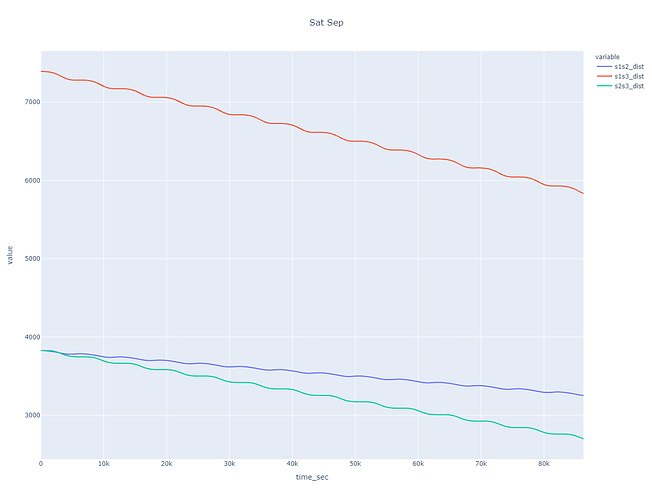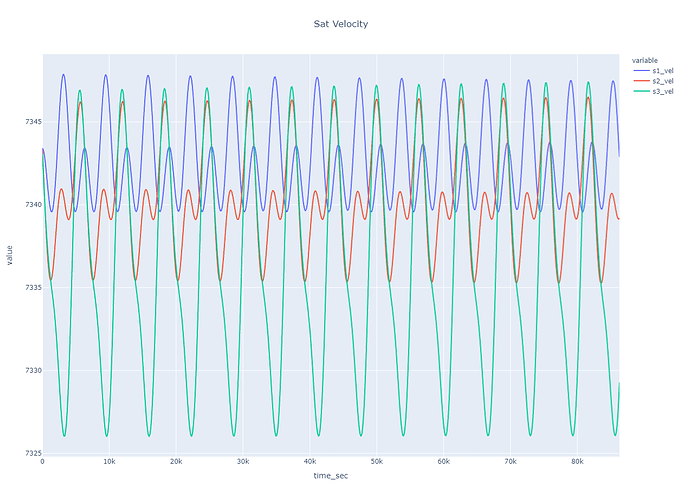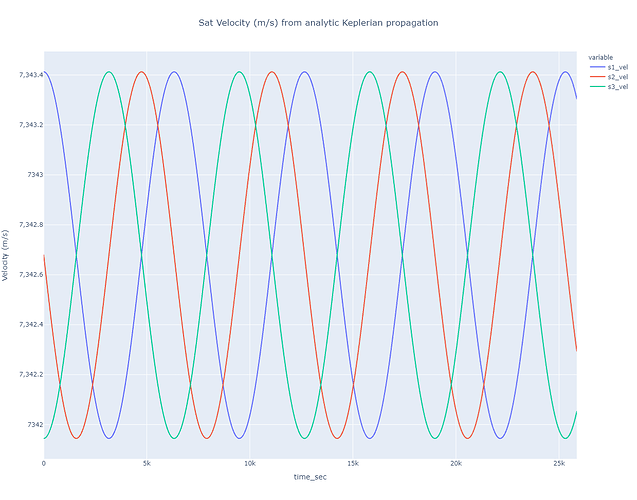Hello!
I’m new to OREKIT and the forum and just getting my feet wet with some basic scripts. Moving beyond the tutorials, I’ve been getting some results I cannot understand which I’ve isolated due to the effect of the normalized gravity provider I’ve pulled from a tutorial, and the max degree/max order used when called.
I’m using a python script with the python wrapper, and the basic task I was trying to test was tracking satellite separation over time for two satellites in a single plane separated by some initial true anomaly (approx circular orbits, ~1000km altitude).
The odd behavior itself is how the sat separation decreases VERY QUICKLY, visible in the plot of sat separations, as well as velocities (plots attached).
Having a hard time believing this a correct astrodynamical effect, so I tested several things and found that if I change the gravity provider from:
gravityProvider = GravityFieldFactory.getNormalizedProvider(8, 8)
to:
gravityProvider = GravityFieldFactory.getNormalizedProvider(1, 1)
… the separation is much more constant with time. This separation drift is also a function of inclination, larger the inclination, larger the effect, but behaves roughly as expected with i < 10 deg
Other ways I’ve tested this and seen the same effect:
- numerical and analytic propagators
- Keplerian and Equinoctial orbit types (all ~1000km altitude)
- Inclinations 0…100, higher inclination, more exaggerated the effect
So I understand the gravity provider as accounting for asymmetries in earth’s field due to mass distributions, but this effect just seems hyper-exaggerated. Does anyone have any insight into this and how to properly do high precision LEO orbit propagations?
Simplified code is below for reference.
Thank you!
'''Set up small number of satellites in ONE constellation plane, and analyze how their separation changes
over time'''
import orekit
from orekit.pyhelpers import setup_orekit_curdir
from orekit import JArray_double
from org.orekit.bodies import OneAxisEllipsoid
from org.orekit.frames import FramesFactory
from org.orekit.time import TimeScalesFactory, AbsoluteDate
from org.orekit.orbits import KeplerianOrbit, OrbitType, EquinoctialOrbit
from org.orekit.propagation.analytical import KeplerianPropagator, EcksteinHechlerPropagator
from org.orekit.utils import Constants
from org.orekit.propagation import SpacecraftState
from org.orekit.orbits import OrbitType, PositionAngle
from org.orekit.propagation.numerical import NumericalPropagator
from org.hipparchus.ode.nonstiff import DormandPrince853Integrator
from org.orekit.forces.gravity.potential import GravityFieldFactory
from org.orekit.forces.gravity import HolmesFeatherstoneAttractionModel
from org.orekit.utils import IERSConventions
import numpy as np
import pandas as pd
import plotly.express as px
from math import radians, degrees, sin, cos, tan
vm = orekit.initVM()
setup_orekit_curdir()
# Set propagator type:
analytic = True
# Times:
# - Overall duration in seconds for extrapolation
duration = 3600 * 24 * 1.0 # hr * 24 * days
step_time = 60.0 * 2
# - Time array in orekit AbsoluteDate format
utc = TimeScalesFactory.getUTC()
startDate = AbsoluteDate(2021, 1, 16, 11, 0, 00.000, utc)
t_arr = [startDate.shiftedBy(float(dt)) for dt in np.arange(0, duration, step_time)] # list of AbsoluteDate objects
t_arr_sec = [i * step_time for i in range(len(t_arr))] # list of ints
# Some Constants
ae = Constants.WGS84_EARTH_EQUATORIAL_RADIUS
mu = Constants.WGS84_EARTH_MU
initialStates = [] # holds sat initial states
prop_list = [] # holds a propagator for each orbit (same prop, diff orbit)
sat_pos = [] # holds lists of Vector3D types for each satellite for each timestamp. Each entry holds every time
sat_vel = []
# Set up Satellites data
# - Polar plane example:
planes = 1
sats = 3
# Equinoctial Orbit elements, common across satellites in-plane:
a = ae + (1000.0 * 1015) # SMA, meters
e_e = 0.0001
i = 99.0 # inclination
raan = radians(0.0) # right ascension of ascending node, rads
#lv = v + ω + Ω # anomaly, see below
# ω is the argument of perigee, Ω is right ascension of ascending node, M is mean anomaly,
# E is eccentric anomaly and υ is true anomaly
dAnom = 30.0 # in plane spacing, true anomaly delta
satellite_mass = 100.0 # kg
# Inertial frame where the satellite is defined
inertialFrame = FramesFactory.getEME2000()
# Set up each orbit state:
for sat in range(sats):
omega = radians(0.0) # perigee argument (pa in Orbit class), rads. TA and MA defined wrt this
raan = radians(0.0) # right ascension of ascending node, rads
t_anom = radians(sat*dAnom) # True anomaly, rads
ex = e_e * cos(omega + raan)
ey = e_e * sin(omega + raan)
hx = tan(i / 2) * cos(raan)
hy = tan(i / 2) * sin(raan)
Lv = t_anom + raan + omega # true longitude argument
equinoc_initialOrbit = EquinoctialOrbit(a,
ex,
ey,
hx,
hy,
Lv,
PositionAngle.TRUE,
inertialFrame, startDate, mu)
initialOrbit = equinoc_initialOrbit
# Make list of initial states, and list of propagators tied 1:1 to each state
initialStates.append(SpacecraftState(initialOrbit, satellite_mass))
#print(*initialStates, sep='\n')
# Propagators:
''' For the numeric propagator to make sense it needs some forces acting on the satellite. Here we are adding a gravity
field model.For a more detailed propagation, other force models can be added.'''
itrf = FramesFactory.getITRF(IERSConventions.IERS_2010, True) # International Terrestrial Reference Frame, earth fixed
earth = OneAxisEllipsoid(Constants.WGS84_EARTH_EQUATORIAL_RADIUS,
Constants.WGS84_EARTH_FLATTENING,
itrf)
gravityProvider = GravityFieldFactory.getNormalizedProvider(8, 8)
#gravityProvider = GravityFieldFactory.getNormalizedProvider(2, 2) # max degree, max order from first supported file
if analytic:
# - Note on EckStein Hechler: It is adapted to nearly circular orbits (eccentricity less than 0.05 and at most 0.1)
# ..and does not work for inclinations close to the critical inclinations (~63.43 deg and ~116.57 deg).
# but EH is also NOT good for very small eccentricities, ~ < e-5. Usable range is 1e-5 < e < 0.1
# - Other analytic options: J2Differential, KeplerianPropagator
for state in initialStates:
pos = []
vel = []
# Choose one propagator:
propagator = EcksteinHechlerPropagator(state.getOrbit(),
Constants.EIGEN5C_EARTH_EQUATORIAL_RADIUS,
Constants.EIGEN5C_EARTH_MU, Constants.EIGEN5C_EARTH_C20,
Constants.EIGEN5C_EARTH_C30, Constants.EIGEN5C_EARTH_C40,
Constants.EIGEN5C_EARTH_C50, Constants.EIGEN5C_EARTH_C60)
# propagator = KeplerianPropagator(state.getOrbit())
# Propagate: prototype is propagate(start,end)
#sat_pos = [propagator.propagate(startDate, t).getPVCoordinates().getPosition() for t in t_arr]
#sat-vel = [propagator.propagate(startDate, t).getPVCoordinates().getVelocity() for t in t_arr]
for t in t_arr:
p_state = propagator.propagate(startDate, t).getPVCoordinates()
pos.append(p_state.getPosition())
vel.append(p_state.getVelocity())
sat_pos.append(pos)
sat_vel.append(vel)
# Calculate separations:
s1s2_dist = [i[0].distance(i[1]) for i in list(zip(sat_pos[0], sat_pos[1]))]
s1s3_dist = [i[0].distance(i[1]) for i in list(zip(sat_pos[0], sat_pos[2]))]
s2s3_dist = [i[0].distance(i[1]) for i in list(zip(sat_pos[1], sat_pos[2]))]
# Calculate velocities:
s1_vel = [v.getNorm() for v in sat_vel[0]]
s2_vel = [v.getNorm() for v in sat_vel[1]]
s3_vel = [v.getNorm() for v in sat_vel[2]]
# Convert to km for plotting:
s1s2_dist = np.divide(s1s2_dist, 1000)
s1s3_dist = np.divide(s1s3_dist, 1000)
s2s3_dist = np.divide(s2s3_dist, 1000)
# Set up df for plotting:
df = pd.DataFrame(data=zip(t_arr_sec, s1s2_dist, s1s3_dist, s2s3_dist,
s1_vel, s2_vel, s3_vel),
columns=['time_sec', 's1s2_dist', 's1s3_dist', 's2s3_dist',
's1_vel', 's2_vel', 's3_vel'])
fig = px.line(df, x='time_sec', y=['s1s2_dist', 's1s3_dist', 's2s3_dist'],
title='Sat Sep')
fig.update_layout(title_x=0.5)
fig.show()
fig = px.line(df, x='time_sec', y=['s1_vel', 's2_vel', 's3_vel'],
title='Sat Velocity')
fig.update_layout(title_x=0.5)
fig.show()
### Note: Nominal sat-sep, based on isosceles triangle:
# - r = 6379 + 1015 = 7394
# - base angle = theta = 180 - 27.692/2 - 90 = 76.154
# - base = 2*r*cos(theta) = 3,538 km
# - Sep between adjacent polar sats is 3,538 km


